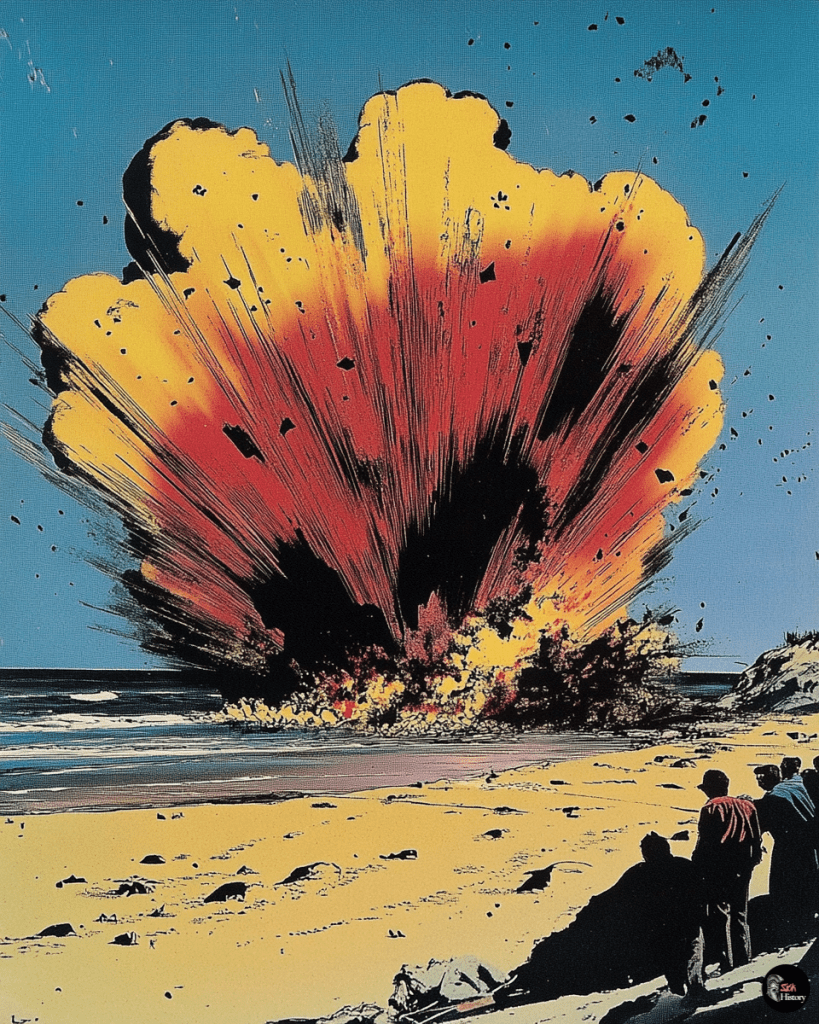On November 12, 1970, an unusual event unfolded on the beach near Florence, Oregon. A 45-foot-long sperm whale carcass had washed ashore, presenting a unique challenge for local authorities.
The Oregon State Highway Division, tasked with maintaining the beaches at the time, faced the dilemma of how to dispose of the massive, decomposing whale.
In a decision that would become infamous, officials chose to use dynamite to remove the whale carcass, resulting in a spectacular and messy explosion that sent chunks of blubber raining down on spectators and nearby vehicles. The incident, captured on film by reporter Paul Linnman of KATU, quickly became a legendary tale in Oregon’s history.
The Florence “Exploding Whale” incident has since gained enduring fame, inspiring countless retellings and even a memorial park.
It also highlights the challenges of dealing with marine mammal strandings on public beaches.
The Oregon Exploding Whale Incident
In 1970, a peculiar event unfolded on the Oregon coast that would become legendary. The disposal of a massive whale carcass near Florence led to unexpected consequences and a memorable news report.
November 12, 1970: The Event
On November 9, 1970, a 45-foot-long sperm whale washed ashore near Florence, Oregon. The whale’s carcass, estimated to weigh 8 tons, quickly became a problem for local authorities.
The Oregon State Highway Division, which had jurisdiction over the beaches at the time, was tasked with removing the decomposing whale. After consulting with the United States Navy, officials made a controversial decision.
They chose to use dynamite to dispose of the carcass, believing the explosion would vaporize the whale and any remaining pieces would be eaten by seagulls.
The Role of Dynamite
Officials placed a half-ton of dynamite next to the whale carcass. The amount was determined based on military advice, though some highway engineers expressed doubts about its effectiveness.
Spectators gathered at a safe distance to witness the event. The explosion was detonated, but the results were far from what officials had anticipated.
Instead of disintegrating, large chunks of blubber were sent flying through the air. Spectators found themselves dodging falling pieces of whale, with some chunks landing as far as a quarter-mile away.
Paul Linnman’s Report
KATU-TV reporter Paul Linnman covered the event, producing a now-famous news segment. His report captured the unexpected outcome and the reactions of stunned onlookers.
Linnman’s deadpan delivery and memorable quotes, such as describing the scene as a “blubber blizzard,” contributed to the incident’s enduring popularity. His report gained renewed attention in the 1990s when it began circulating on the early internet.
The video footage showcased the miscalculation of using explosives and the chaotic aftermath, including a smashed car roof from falling whale debris.
Exploding Whale Memorial Park
Decades after the incident, Florence, Oregon, embraced its unusual claim to fame. In 2020, the city dedicated Exploding Whale Memorial Park to commemorate the 50th anniversary of the event.
The park, located near the original explosion site, features informational plaques detailing the incident. It serves as a quirky tourist attraction and a reminder of the unintended consequences of the whale disposal attempt.
This dedication reflects how the exploding whale incident has become an integral part of local lore and Oregon’s coastal history.
Aftermath and Environmental Considerations
The 1970 whale explosion in Florence, Oregon, prompted significant changes in carcass disposal methods and raised awareness about sperm whale biology and stranding events. Environmental impacts and public safety concerns became paramount in future decision-making processes.
Carcass Disposal Practices
After the explosive incident, authorities reconsidered their approach to handling beached whale carcasses. In 1979, when 41 sperm whales stranded south of Florence, officials opted for burial rather than detonation. This shift marked a more cautious and environmentally conscious strategy.
Burial became the preferred method, minimizing risks to public safety and reducing environmental impact. In some cases, towing carcasses out to sea or allowing natural decomposition on remote beaches became viable alternatives.
Modern disposal practices now prioritize both environmental considerations and practical feasibility. Specialized equipment and techniques have been developed to handle large marine mammal carcasses efficiently and safely.
Sperm Whale Biology and Stranding
Sperm whales, the species involved in the Florence incident, are deep-diving cetaceans known for their massive size. Adult males can reach lengths of up to 60 feet and weigh up to 45 tons.
Strandings of sperm whales are relatively rare but not uncommon. These events often involve lone individuals or small groups.
Causes of strandings can include:
- Navigation errors
- Illness or injury
- Disturbances in their echolocation abilities
When strandings occur, rapid response teams assess the situation. If the whale is alive, attempts may be made to refloat it.
For deceased whales, disposal decisions consider factors such as location, size, and potential environmental impacts.
Research into sperm whale biology and behavior has advanced significantly since the 1970 incident, informing better management strategies for stranding events.

